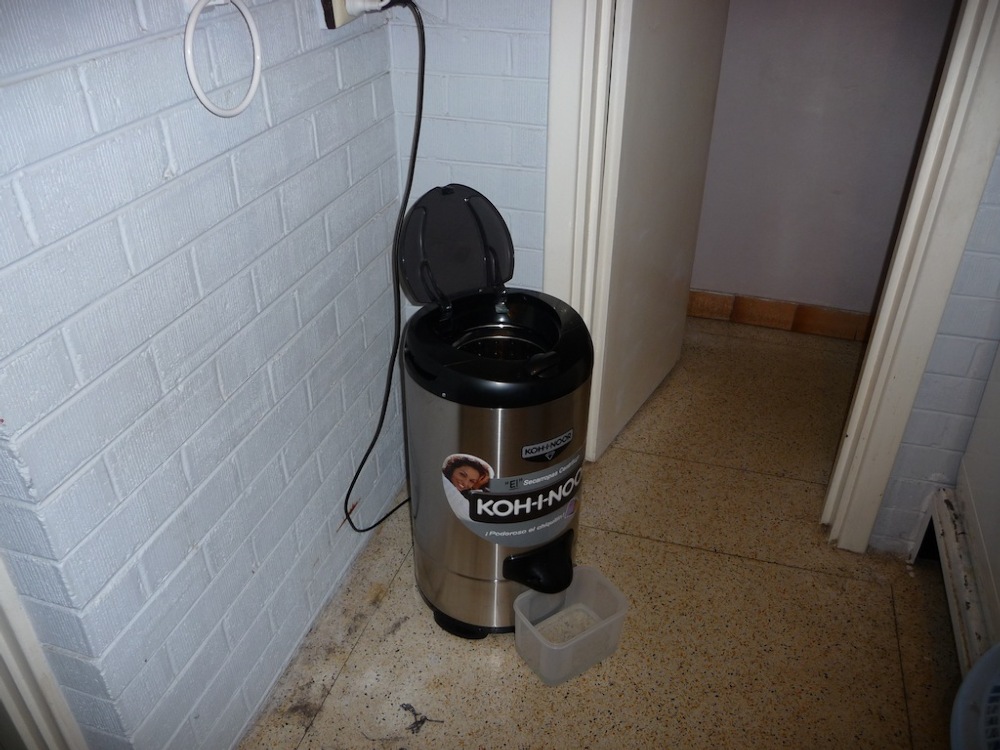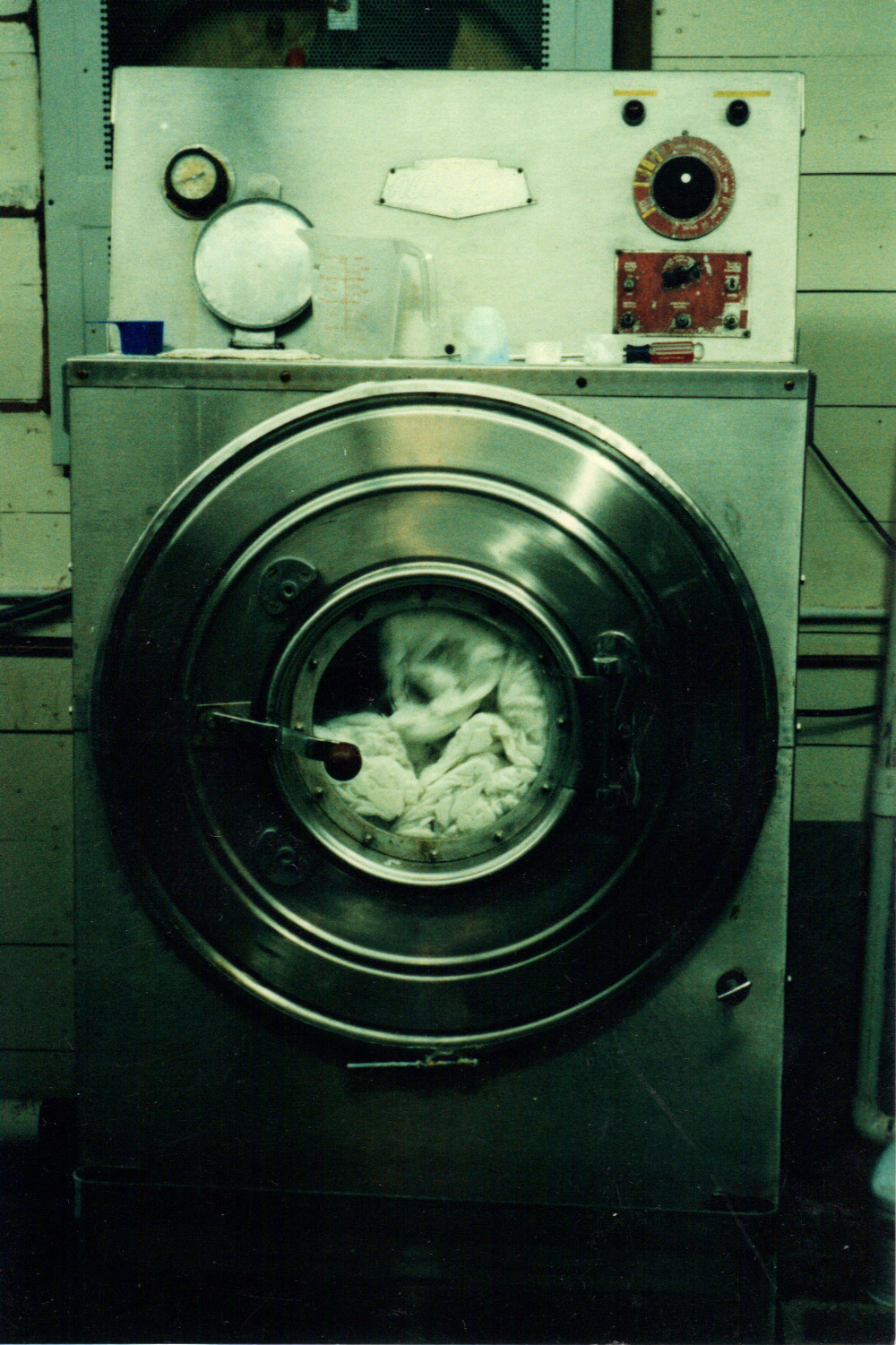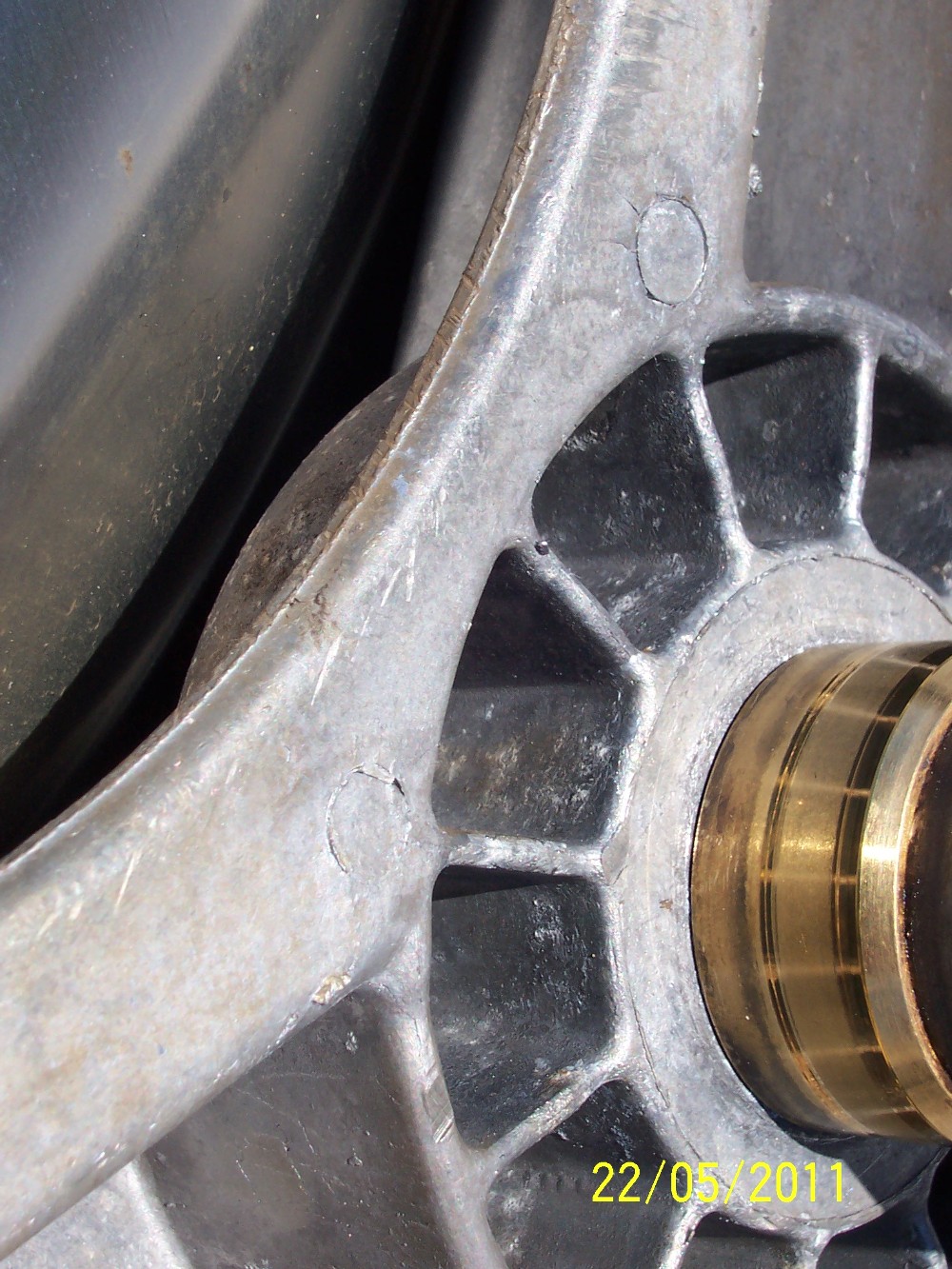|
Thread Number: 34695
My New 'Koh-I-Noor' 2800RPM Spin Dryer |
[Down to Last] |
Post# 520297 5/25/2011 at 01:43 (4,812 days old) by mattywashboy  (Perth, Western Australia) (Perth, Western Australia) |
||

Hi Guys
Just taken delivery of a new purchase (its never ending these days) for the laundry room. Its a Koh-I-Noor Eco Spin Dryer, 2800RPM. Holds 5.2kg of clothes. I was searching around the internet for any spin dryers available in Australia, there appeared to be none to be found. Then I found a link via Twitter for the Oziel Eco Appliance website and they have just begun to import Koh I Noor spinners into Australia, with Sydney as their base. Its an Argentinian based company I believe. Anyway I shot the guys an email asking about prices and shipping to WA. They were so good and informative and sent a lot of info on the appliance. I considered it for about a fortnight (during which I got the Frigidaire washer) and then sent off the money and they packed it, shipped it and it was on its way. I have never really used a spin dryer before, my family in England had a few amongst them but I never saw them using it, the closest I got was the spin dryer on my grandmothers Servis SuperTwin and my other grandmothers Hoovermatic, both of which I was terrified of because of the noise. In later life my Hoovermatic Grandmother had a spinner in the corner of the kitchen but she never used it while I was around, she was from the era where you got up at 5am and did all your laundry before 9am before heading down into the town to shop... I bought one because of the busy lifestyle I lead and the struggle to get laundry dry in the cold Perth winter without running the dryer for hours and hours on end. I set aside one or two days and if I don't get my laundry done on those days then it gets leftover to the next week... The Spinner really does get much more water out after the 900rpm spin in the Frigidaire, teas towels and socks come out almost dry and towels come out needing only an hour or so on the line. I am yet to try it on T-shirts and such but all will remain to be seen, so far, very impressed. If any other Australians are interested in this appliance I will put a link at the end of this post to their website, it is still under construction but the email address is there for sales. I paid $466 for the machine, 1 year warranty and shipping to Perth. For now here are the obligatory pictures and a short video... Enjoy Matty CLICK HERE TO GO TO mattywashboy's LINK 
| ||

|
Post# 520298 , Reply# 1 5/25/2011 at 01:44 (4,812 days old) by mattywashboy  (Perth, Western Australia) (Perth, Western Australia) |
||
 | ||
Post# 520299 , Reply# 2 5/25/2011 at 01:46 (4,812 days old) by mattywashboy  (Perth, Western Australia) (Perth, Western Australia) |
||
 | ||
Post# 520300 , Reply# 3 5/25/2011 at 01:49 (4,812 days old) by mattywashboy  (Perth, Western Australia) (Perth, Western Australia) |
||

Finally the very simple video I quickly made.
Apologies for the dust and dog hair around the floor, once the laundry was all done i went into the mad sweeping vaccuuming mopping phase of my one of two days off from work. Leave it up to the housemates and we would be able to build a replica of the Titanic out of dog hair.... Anyway thats all for now, thanks for viewing :-) Till next time. M | ||
Post# 520301 , Reply# 4 5/25/2011 at 02:24 (4,812 days old) by rp2813  (Sannazay) (Sannazay) |
||
 | ||
Post# 520321 , Reply# 5 5/25/2011 at 05:54 (4,811 days old) by tolivac  (greenville nc) (greenville nc) |
||
|
Now put this on the VFD motor drive controller! | ||
| Post# 520339 , Reply# 7 5/25/2011 at 08:55 (4,811 days old) by 3beltwesty () | ||
|
"YOU GET MORE FROM KOH I NOOR!" RE "Koh I Noor brand I'm familiar with is the one that makes (made?) Rapidograph technical pens" As once a Koh I Noor dealer; their slogan for technical pens was "YOU GET MORE FROM KOH I NOOR!" | ||
Post# 520342 , Reply# 8 5/25/2011 at 09:07 (4,811 days old) by mattywashboy  (Perth, Western Australia) (Perth, Western Australia) |
||

Hey Limey
Yes the laundry in the spinner was out of the Frigidaire after a Regular spin at 900rpm, never timed how long the spin is. This was just a small load in the spin dryer of small socks and tea towels, i still couldn't believe how much more water it was able to drag out. When I spun the other half of the load which were big bulky bath towels, the water was virtually flowing out of the spinner, brilliant because they only needed a small amount of time on the line before they were dry. Not sure what the diameter of the tub is, around 12 inches sounds about right but i can't find it on the machine. I am very happy with it so far, washing my clothes tomorrow so will see how it does on (a) my jeans and (b) my light t-shirts, wondering if it will crease them too much but i imagine they would just be about ready for ironing once coming out of the spin. The Frigidaire is not the best at rinsing. It uses a low level and does two short spins in between the rinses if you use Extra Rinse (i always do). With E.R not selected you get a slightly longer 600rpmish spin. THe spinner certainly dragged out more soap and dirt. | ||
| Post# 520353 , Reply# 9 5/25/2011 at 10:29 (4,811 days old) by limey () | ||
|
Drum Diameter of Spin Dryer Matt, For the diameter of the drum just measure the diameter of the 'safety disc' you refered to in the video. | ||
| Post# 520374 , Reply# 10 5/25/2011 at 12:50 (4,811 days old) by mixfinder () | ||
|
Time for New Glasses I wasn't able see soil in the extracted water and an opaque container on a yellow floor could certainly "color" the outcome. | ||
| Post# 520383 , Reply# 11 5/25/2011 at 13:36 (4,811 days old) by arbilab (Ft Worth TX (Ridglea)) | ||

Which Frigi are we looking at, and how much difference is there between two of them? Mine is from 1998, the first one offered in US, 800r spin, but it has FIVE rinses. Sudsaway spray and 4 fills. If I've dosed detergent right, final rinse water looks like I could drink it.
Besides the nostalgia of growing up with FL, I paid more than double the TL price for this thing specifically because FL rinses better with less water. In a large volume single rinse, what's left after wash spin can only get "so" diluted, and the same remnants in the rinse water remains in the load. In multiple small volume rinses, the remnants get progressively diluted and extracted. Not possible to convince me that a single 16 gallon rinse works better than four 4 gallon rinses. | ||
| Post# 520410 , Reply# 12 5/25/2011 at 15:29 (4,811 days old) by whirlcool (Just North Of Houston, Texas) | ||
|
That looks like a nice machine of high quality. It sounds very quiet and almost no vibration. You'll love how much water it takes out of shirts and denims! | ||
| Post# 520452 , Reply# 14 5/25/2011 at 19:33 (4,811 days old) by Streakers (Columbus Ohio) | ||
|
Love it! and want one! Matty could you please provide me with the details of their website? I've just done a quick search - but can't find a website for them?? Many thanks and Congrats on your purchase! Cheers Steve | ||
Post# 520470 , Reply# 15 5/25/2011 at 20:35 (4,811 days old) by mattywashboy  (Perth, Western Australia) (Perth, Western Australia) |
||
 | ||
| Post# 520502 , Reply# 16 5/25/2011 at 23:27 (4,811 days old) by arbilab (Ft Worth TX (Ridglea)) | ||
 | ||
Post# 520531 , Reply# 17 5/26/2011 at 00:32 (4,811 days old) by Supersuds  (Knoxville, Tenn.) (Knoxville, Tenn.) |
||
Koh-i-noor | ||
| Post# 521072 , Reply# 19 5/28/2011 at 15:05 (4,808 days old) by arbilab (Ft Worth TX (Ridglea)) | ||
 | ||
| Post# 521128 , Reply# 20 5/28/2011 at 18:58 (4,808 days old) by Rolls_rapide (.) | ||
|
"Safety Disc" That would be known as the "spin mat". | ||
Post# 521154 , Reply# 21 5/28/2011 at 20:42 (4,808 days old) by Launderess  (Quiet Please, There´s a Lady on Stage) (Quiet Please, There´s a Lady on Stage) |
||
Spin Mat On My Paki Built Spin Drier
Tore itself into halves within the first week of use.
Not one to be put off by minor details, simply took some flannel yardage one had in the sewing kit and used it instead. Now before anyone wags their finger, extractors have been around longer than those little mats, and until they came upon the scene operators simply took a heavy/thick towel or other material and put it over the load. What is important is that one pushes the load down into the extractor, and that is isn't over loaded. If this done there is little chance for "rug burns" to materials from being rubbed about at high speed. It is also important to place small items in mesh bags or at least load them first so larger things will cover. | ||
| Post# 521204 , Reply# 22 5/29/2011 at 03:15 (4,808 days old) by arbilab (Ft Worth TX (Ridglea)) | ||
 | ||
Post# 521295 , Reply# 26 5/29/2011 at 14:35 (4,807 days old) by Launderess  (Quiet Please, There´s a Lady on Stage) (Quiet Please, There´s a Lady on Stage) |
||
Love That Vintage Detergent HandBook
Have been trying to score one, but the costs even on fleaPay are a bit dear pour moi. Good to see another "vintage" soap/detergent book buff here in the group! *LOL*
Extraction between rinses also saves water and cycle time. Commercial (and domestic for that matter), H-Axis washers can give the same rinse results using fewer cycles if extractions take place between each rinse. My older Miele only does one short extraction after the third then a full after the fourth, and of course a series of final spins after the fifth (graduated then full). Newer Miele units only have the three rinses and by all accounts can do just as well. Major complaint seems to be about water levels for these rinses, but that is another matter. High Titer Soap: Discussed this in another thread. High titer soaps need temps >130 indeed >140 to wash and rinse well. Otherwise not only is cleaning performance reduced but unrinsed soap will carry over into the sour bath (not good), and also remain giving laundry a residue that will eventually have a whiff, not to mention "tattle-tale grey tint. High titer soaps are those composed in whole or part of animal fats, thus some of the most common in America at one time. From home made using rendered household fats. Everything from bacon/meat drippings to whatever was left from domestic animal slaughter (for those living on farm), went into this stuff. On a commercial scale it would have been the same thing, especially after Mr. Armour discovered and promoted that nothing should be wasted from his meatpacking business. Use of high titer soaps was one of the reasons laundry was boiled after being soaked, then hand washed. One needed that high temp water to remove all that soap. | ||
Post# 521296 , Reply# 27 5/29/2011 at 14:37 (4,807 days old) by Launderess  (Quiet Please, There´s a Lady on Stage) (Quiet Please, There´s a Lady on Stage) |
||
Spin-X & The Miele
Don't know about front loaders where the final spin is >1200 rpms, but for my Miele putting items into the spin dryer after being spun at 900rpms does remove a decent amount of water (and detergent residue for that matter), from the wash.
If one is going to line dry things then it's not usually worth the bother, but for machine drying it does knock off some time and thus save energy/money. | ||
| Post# 521310 , Reply# 28 5/29/2011 at 16:39 (4,807 days old) by sudsman () | ||
|
Tom I know the book As I remember it has formulas for family work and hotel and hospital work, That was when we could wash with as much water as we liked and no one scolded us. And our work was CLEAN to the last sock. 
| ||
| Post# 521316 , Reply# 29 5/29/2011 at 16:51 (4,807 days old) by Tomturbomatic (Beltsville, MD) | ||
|
Laundress, I don't know if it was my book you were talking about, but it is available on Amazon for as litle as $10.00 | ||
| Post# 521459 , Reply# 33 5/30/2011 at 11:59 (4,806 days old) by limey () | ||
|
Spider Corrosion Spider shown in post 521458 above after pressure washer cleaning. 
| ||
Post# 521473 , Reply# 34 5/30/2011 at 12:40 (4,806 days old) by Launderess  (Quiet Please, There´s a Lady on Stage) (Quiet Please, There´s a Lady on Stage) |
||
Oh Lord | ||
| Post# 521479 , Reply# 35 5/30/2011 at 13:19 (4,806 days old) by sudsman () | ||
|
Exactly what I think too. He who stir up old shit make big stink! | ||
| Post# 521512 , Reply# 36 5/30/2011 at 16:38 (4,806 days old) by Tomturbomatic (Beltsville, MD) | ||
|
Sorry. | ||
| Post# 521513 , Reply# 37 5/30/2011 at 16:40 (4,806 days old) by sudsman () | ||
|
Tom Did not mean you at all.. | ||
Post# 521537 , Reply# 40 5/30/2011 at 20:09 (4,806 days old) by Launderess  (Quiet Please, There´s a Lady on Stage) (Quiet Please, There´s a Lady on Stage) |
||
Limey | ||

 Comes to the Rescue!
Comes to the Rescue!